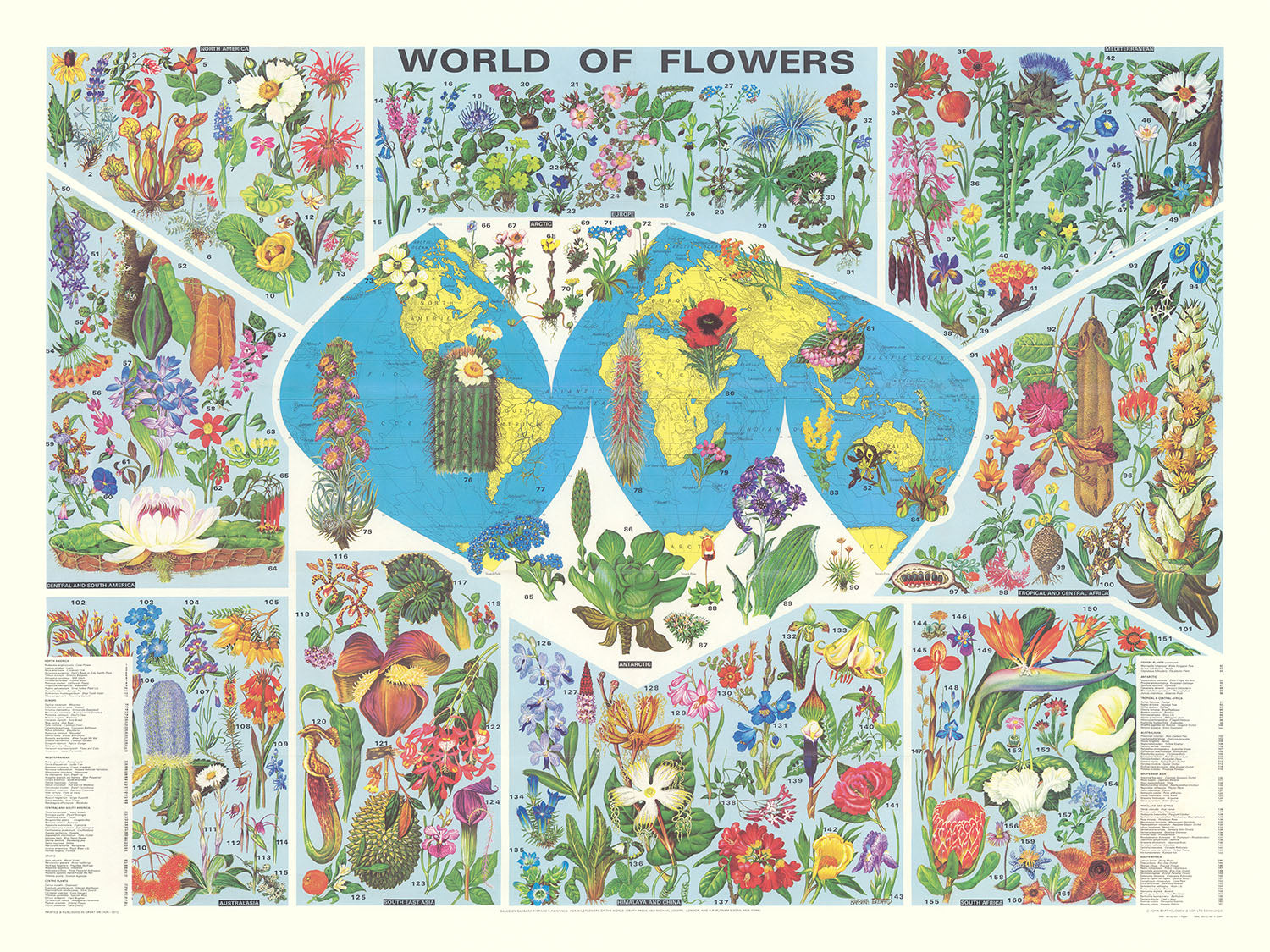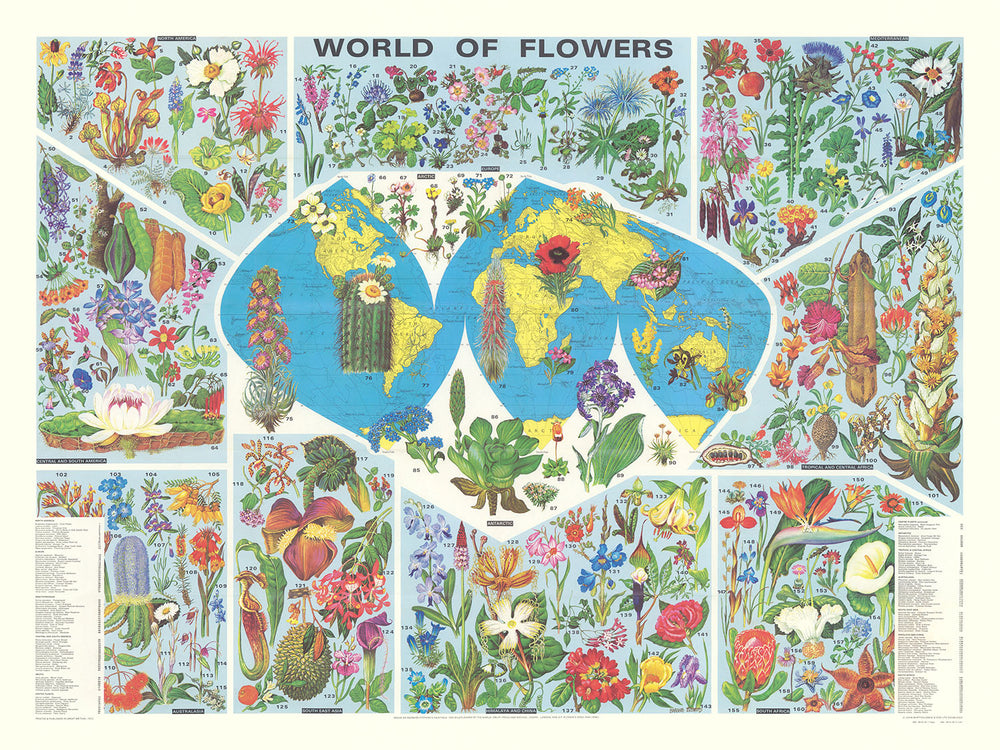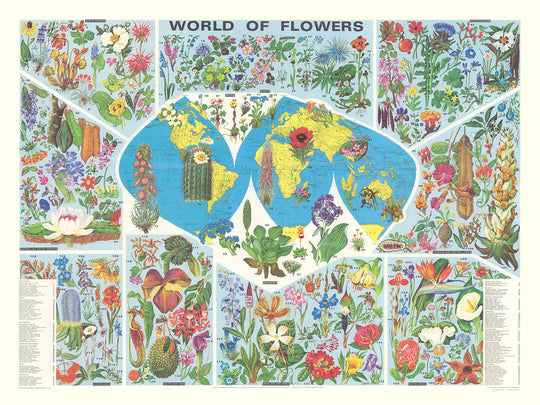- Handmade locally. No import duty or tax
- FREE Delivery. Arrives in 2-3 days
- Love it or your money back
- Questions? WhatsApp me any time
Own a piece of history
5,000+ 5 star reviews


The "World of Flowers" map, created by the renowned botanical illustrator Barbara Everard in 1972, is a captivating thematic infographic that elegantly combines scientific precision with artistic beauty. This map meticulously charts the global distribution of 161 flower species, presenting a rich tapestry of botanical diversity. Each flower is vividly illustrated in color, making this map not only a valuable educational resource but also a stunning piece of art. The central world map, surrounded by detailed panels of flower illustrations, provides an immersive visual experience that invites viewers to explore the floral wonders of our planet.
The map highlights broad regions such as North America, the Mediterranean, Southeast Asia, South Africa, and the Arctic, each known for their unique flora. The inclusion of topographical features, including ocean floor contours and land relief, adds a geographical dimension that enhances the viewer's understanding of the natural habitats of these flowers. This thoughtful integration of botanical and geographical information makes the map a comprehensive guide to the world's wildflowers.
Barbara Everard's expertise in botanical illustration shines through in this map. Known for her contributions to "Wildflowers of the World," Everard's work is characterized by its accuracy and attention to detail. Each flower on the map is carefully numbered and indexed, allowing for easy identification and study. This level of detail reflects Everard's dedication to her craft and her passion for sharing the beauty of the natural world with others.
The "World of Flowers" map is more than just a visual delight; it is a valuable historical document that captures the botanical knowledge of the early 1970s. It serves as a snapshot of the era's scientific understanding and appreciation of plant diversity. By presenting this information in an accessible and engaging format, the map encourages a deeper appreciation for the intricate relationships between plants and their environments.
This map is a perfect addition to any collection, whether for educational purposes, botanical study, or simply as a beautiful piece of art. Its detailed illustrations and comprehensive indexing make it a useful tool for botanists and enthusiasts alike. The "World of Flowers" map stands as a testament to Barbara Everard's legacy and her contribution to the field of botanical illustration, offering a timeless exploration of the world's floral treasures.
Places on this map
- Continents:
- North America
- South America
- Europe
- Africa
- Asia
- Australia
- Antarctica
- Regions:
- Mediterranean
- Southeast Asia
- Arctic
- South Africa
- Oceans:
- Atlantic Ocean
- Pacific Ocean
- Indian Ocean
- Southern Ocean
- Notable Geographical Features:
- Ocean floor contours
- Land relief contours
- Flower Species Locations:
- Specific locations across the globe where various flower species are found
Notable Features & Landmarks
- Central World Map:
- Displays the global distribution of flower species.
- Shows topographical features including ocean floor contours and relief.
- Illustrated Flower Panels:
- Surrounding the central map are panels with colored illustrations of 161 flower species.
- Each flower is numbered and corresponds to an indexed key.
- Indexed Key:
- Located at the bottom left and right of the map.
- Provides the names and details of the flower species illustrated.
- Topographical Features:
- Includes contours representing ocean floor relief.
- Depicts land relief through shading and contour lines.
- Regions Highlighted:
- North America, Mediterranean, Southeast Asia, South Africa, and the Arctic are particularly noted for their flower species.
- Detailed Illustrations:
- Each flower is meticulously illustrated in color, showcasing botanical details.
Historical and design context
- Name of the map: World of Flowers
- Creation date: 1972
- Mapmaker/Publisher: Barbara Everard
- Context about the mapmaker: Barbara Everard was known for her detailed botanical illustrations, contributing to works like "Wildflowers of the World."
- Topics and themes shown on the map:
- This is an infographic thematic map focusing on the distribution of flower species across the globe.
- The map highlights the locations of 161 different flower species.
- Each flower is illustrated in color and indexed with a key at the bottom left and right of the map.
- The map also depicts topographical features, including ocean floor contours and relief.
- Design or style of the map:
- The map features colored illustrations of flowers based on Barbara Everard's paintings.
- It includes a central world map with surrounding panels showcasing detailed illustrations of the flowers.
- Historical significance or context:
- The map combines scientific accuracy with artistic representation, making botanical knowledge accessible and engaging.
- It reflects the botanical interests and knowledge of the early 1970s.
Please double check the images to make sure that a specific town or place is shown on this map. You can also get in touch and ask us to check the map for you.
This map looks great at every size, but I always recommend going for a larger size if you have space. That way you can easily make out all of the details.
This map looks amazing at sizes all the way up to 100in (250cm). If you are looking for a larger map, please get in touch.
Please note: the labels on this map are hard to read if you order a map that is 20in (50cm) or smaller. The map is still very attractive, but if you would like to read the map easily, please buy a larger size.
The model in the listing images is holding the 18x24in (45x60cm) version of this map.
The fifth listing image shows an example of my map personalisation service.
If you’re looking for something slightly different, check out my collection of the best old maps to see if something else catches your eye.
Please contact me to check if a certain location, landmark or feature is shown on this map.
This would make a wonderful birthday, Christmas, Father's Day, work leaving, anniversary or housewarming gift for someone from the areas covered by this map.
This map is available as a giclée print on acid free archival matte paper, or you can buy it framed. The frame is a nice, simple black frame that suits most aesthetics. Please get in touch if you'd like a different frame colour or material. My frames are glazed with super-clear museum-grade acrylic (perspex/acrylite), which is significantly less reflective than glass, safer, and will always arrive in perfect condition.
This map is also available as a float framed canvas, sometimes known as a shadow gap framed canvas or canvas floater. The map is printed on artist's cotton canvas and then stretched over a handmade box frame. We then "float" the canvas inside a wooden frame, which is available in a range of colours (black, dark brown, oak, antique gold and white). This is a wonderful way to present a map without glazing in front. See some examples of float framed canvas maps and explore the differences between my different finishes.
For something truly unique, this map is also available in "Unique 3D", our trademarked process that dramatically transforms the map so that it has a wonderful sense of depth. We combine the original map with detailed topography and elevation data, so that mountains and the terrain really "pop". For more info and examples of 3D maps, check my Unique 3D page.
For most orders, delivery time is about 3 working days. Personalised and customised products take longer, as I have to do the personalisation and send it to you for approval, which usually takes 1 or 2 days.
Please note that very large framed orders usually take longer to make and deliver.
If you need your order to arrive by a certain date, please contact me before you order so that we can find the best way of making sure you get your order in time.
I print and frame maps and artwork in 23 countries around the world. This means your order will be made locally, which cuts down on delivery time and ensures that it won't be damaged during delivery. You'll never pay customs or import duty, and we'll put less CO2 into the air.
All of my maps and art prints are well packaged and sent in a rugged tube if unframed, or surrounded by foam if framed.
I try to send out all orders within 1 or 2 days of receiving your order, though some products (like face masks, mugs and tote bags) can take longer to make.
If you select Express Delivery at checkout your order we will prioritise your order and send it out by 1-day courier (Fedex, DHL, UPS, Parcelforce).
Next Day delivery is also available in some countries (US, UK, Singapore, UAE) but please try to order early in the day so that we can get it sent out on time.
My standard frame is a gallery style black ash hardwood frame. It is simple and quite modern looking. My standard frame is around 20mm (0.8in) wide.
I use super-clear acrylic (perspex/acrylite) for the frame glass. It's lighter and safer than glass - and it looks better, as the reflectivity is lower.
Six standard frame colours are available for free (black, dark brown, dark grey, oak, white and antique gold). Custom framing and mounting/matting is available if you're looking for something else.
Most maps, art and illustrations are also available as a framed canvas. We use matte (not shiny) cotton canvas, stretch it over a sustainably sourced box wood frame, and then 'float' the piece within a wood frame. The end result is quite beautiful, and there's no glazing to get in the way.
All frames are provided "ready to hang", with either a string or brackets on the back. Very large frames will have heavy duty hanging plates and/or a mounting baton. If you have any questions, please get in touch.
See some examples of my framed maps and framed canvas maps.
Alternatively, I can also supply old maps and artwork on canvas, foam board, cotton rag and other materials.
If you want to frame your map or artwork yourself, please read my size guide first.
My maps are extremely high quality reproductions of original maps.
I source original, rare maps from libraries, auction houses and private collections around the world, restore them at my London workshop, and then use specialist giclée inks and printers to create beautiful maps that look even better than the original.
My maps are printed on acid-free archival matte (not glossy) paper that feels very high quality and almost like card. In technical terms the paper weight/thickness is 10mil/200gsm. It's perfect for framing.
I print with Epson ultrachrome giclée UV fade resistant pigment inks - some of the best inks you can find.
I can also make maps on canvas, cotton rag and other exotic materials.
Learn more about The Unique Maps Co.
Map personalisation
If you're looking for the perfect anniversary or housewarming gift, I can personalise your map to make it truly unique. For example, I can add a short message, or highlight an important location, or add your family's coat of arms.
The options are almost infinite. Please see my map personalisation page for some wonderful examples of what's possible.
To order a personalised map, select "personalise your map" before adding it to your basket.
Get in touch if you're looking for more complex customisations and personalisations.
Map ageing
I have been asked hundreds of times over the years by customers if they could buy a map that looks even older.
Well, now you can, by selecting Aged before you add a map to your basket.
All the product photos you see on this page show the map in its Original form. This is what the map looks like today.
If you select Aged, I will age your map by hand, using a special and unique process developed through years of studying old maps, talking to researchers to understand the chemistry of aging paper, and of course... lots of practice!
If you're unsure, stick to the Original colour of the map. If you want something a bit darker and older looking, go for Aged.
If you are not happy with your order for any reason, contact me and I'll get it fixed ASAP, free of charge. Please see my returns and refund policy for more information.
I am very confident you will like your restored map or art print. I have been doing this since 1984. I'm a 5-star Etsy seller. I have sold tens of thousands of maps and art prints and have over 5,000 real 5-star reviews. My work has been featured in interior design magazines, on the BBC, and on the walls of dozens of 5-star hotels.
I use a unique process to restore maps and artwork that is massively time consuming and labour intensive. Hunting down the original maps and illustrations can take months. I use state of the art and eye-wateringly expensive technology to scan and restore them. As a result, I guarantee my maps and art prints are a cut above the rest. I stand by my products and will always make sure you're 100% happy with what you receive.
Almost all of my maps and art prints look amazing at large sizes (200cm, 6.5ft+) and I can frame and deliver them to you as well, via special oversized courier. Contact me to discuss your specific needs.
Or try searching for something!















































